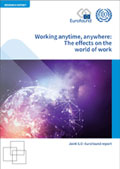Tools and Services on National Employment Policies
2017
-
Series: Guides for Integrated Rural Access Planning and Community Contracting in the Water and Sanitation sector
Conceptual guide for Integrated Rural Access Planning and Community Contracting in the Water and Sanitation sector: Guide No.1
15 February 2017
-

Report
Working anytime, anywhere: The effects on the world of work
15 February 2017
This report considers the impact of telework/ICT-mobile work on the world of work. It synthesises research carried out by Eurofound’s network of European correspondents and ILO country experts.
-
Publication
The role of labour market and sectoral policies in promoting more and better jobs in low middle income countries: Issues, evidence and policy options: The case of India
19 January 2017
EMPLOYMENT Working Paper No. 206
2016
-
Conditions of Work and Employment Series No. 85
Evaluating the effects of the structural labour market reforms on collective bargaining in Greece
15 December 2016
The present report assesses the social and economic impact of the changes in the regulatory framework of collective bargaining in Greece.
-

Extension of Social Security - Working Paper - ESS 55
Health workforce: A global supply chain approach. New data on the employment effects of health economies in 185 countries.
08 December 2016
This paper provides evidence that investments in health protection not only impact on the achievement of health objectives, but also create an important source of employment across numerous economic sectors.
-

Publication
The role of labour market and sectoral policies in promoting more and better jobs in China: Issues, evidence and policy options
25 November 2016
EMPLOYMENT Working Paper No. 208
-
ILO What Works Research Brief No. 5
Employment Protection Legislation to Promote Quality of Job Creation
02 November 2016
An effective system of Employment Protection Legislation (EPL) must balance, among other things, the needs of workers for income and job security with employers’ need to adjust the workforce in an increasingly dynamic world of work. Indeed, rather than debating the benefits of more versus less EPL, more attention should be paid to the correct design of EPL, its interaction with other benefits, and its implementation and effective enforcement.
-

Publication
Boosting youth employment through public works
31 October 2016
EMPLOYMENT Working Paper No. 203
-
Conditions of Work and Employment Series No. 59
The (missing) link between wages and productivity in the Philippines: What role for collective bargaining and the new two-tier wage system?
07 October 2016
-

Issue Brief no. 4 - Labour Relations and Collective Bargaining
Negotiating for gender equality
27 September 2016
Inequality of opportunity, treatment and outcomes between women and men still persists in global labour markets. Achieving gender equality in the workplace remains one of the biggest challenges for governments, social partners and management at enterprise level. Gender-based discrimination often occurs at the recruitment stage on grounds of pregnancy, or potential child bearing and rearing and the gender pay gap remains high across the world. In addition, women are more likely to be affected by violence at work, whether physical, psychological or sexual. This Issue Brief focuses on the obstacles to gender equality at work and how collective bargaining can be used as an effective tool to overcome these challenges.